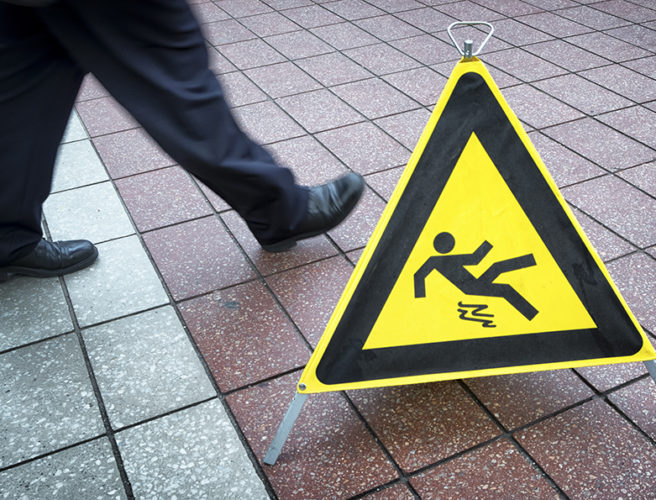Falls account for more than 400,000 workplace injuries each year. In the majority of these the victim slipped, tripped or fell right on the same level where they were walking. Slips result in head or back injuries, lacerations, fractures, pulled muscles and deep contusions. The following tips can help employees avoid some common hazards that cause slips, trips and falls:
SLIPS
Slips happen when there is too little traction between footwear and the walking surface.
Common causes of slips are:
- wet or oily surfaces
- inattention
- spills
- weather hazards
- loose or unanchored rugs and mats
- poor footwear choices
To prevent slips:
- clean up spilled liquids or tracked-in water immediately
- wear slip-resistant shoes when wet and/or icy surfaces are likely
- ask for assistance to and from your car when surfaces are slick
- when walking, keep your center of balance under you
- take smaller steps and make wider turns
- fix leaky equipment and use drip pans to catch ongoing leaks
- mark or barricade slick areas until they are cleaned up
- wipe your feet on entrance mats when it is raining, snowy, icy or muddy outside
- walk carefully on waxed floors
TRIPS
Trips happen when the foot strikes an object causing a loss of balance.
Common causes of trips are:
- obstructed view
- poor lighting
- clutter
- cords and cables
- open drawers
- uneven walking surfaces (steps, thresholds, curbs)
To avoid trips:
- watch where you are going
- keep pathways and work areas clean
- sweep up loose debris and put trash in the trash bins
- properly store tools and supplies that aren’t in use
- report to maintenance any loose or missing tiles, warped or cracked flooring, and turned up rugs
- securely attach rugs and runners to the floor
- hold down cables and cords with rubber coverings or reroute them
- tape down and mark temporary cords and cables
- close file cabinets and drawers
- inspect the grounds and parking lots for trip hazards and make necessary repairs
- pay attention when flooring is uneven, changes level or changes surface
- turn on lights before entering an area or use a flashlight if entering a dark area
- do not carry a load that blocks your vision
FALLS
Using ladders improperly or using makeshift ladders is the number one cause of falls at work. Never use boxes, shelves, chairs or student desks to reach a height. Get a ladder. When using a ladder:
- lock the legs into position and make sure ladder is stable
- check for loose or broken rungs and rails
- make sure it is tall enough
- never use the top two steps or rungs
- place the base of an extension ladder one foot away from the wall for every four feet of height
- keep your body centered on the ladder and face the ladder at all times
- place both feet firmly on the ladder rungs or steps
- before working on a ladder in a doorway, lock the door or prop it open so no one will open the door and knock you over
Both slips and trips result from some kind of unintended or unexpected change in the contact between the feet and the ground or walking surface. This shows that good housekeeping, quality of walking surfaces (flooring), selection of proper footwear, and appropriate pace of walking are also critical for preventing fall accidents.



Leave A Comment